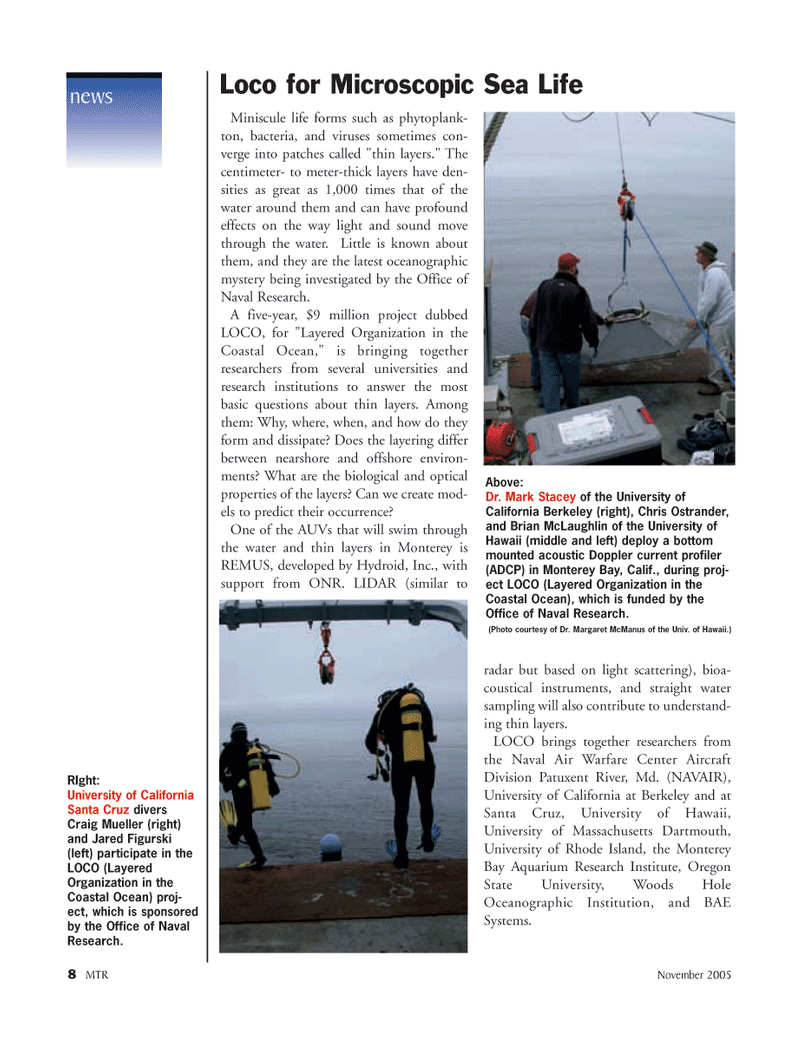
Page 8: of Marine Technology Magazine (November 2005)
Seafloor Engineering
Read this page in Pdf, Flash or Html5 edition of November 2005 Marine Technology Magazine
8 MTR November 2005
Miniscule life forms such as phytoplank- ton, bacteria, and viruses sometimes con- verge into patches called "thin layers." The centimeter- to meter-thick layers have den- sities as great as 1,000 times that of the water around them and can have profound effects on the way light and sound move through the water. Little is known about them, and they are the latest oceanographic mystery being investigated by the Office of
Naval Research.
A five-year, $9 million project dubbed
LOCO, for "Layered Organization in the
Coastal Ocean," is bringing together researchers from several universities and research institutions to answer the most basic questions about thin layers. Among them: Why, where, when, and how do they form and dissipate? Does the layering differ between nearshore and offshore environ- ments? What are the biological and optical properties of the layers? Can we create mod- els to predict their occurrence?
One of the AUVs that will swim through the water and thin layers in Monterey is
REMUS, developed by Hydroid, Inc., with support from ONR. LIDAR (similar to radar but based on light scattering), bioa- coustical instruments, and straight water sampling will also contribute to understand- ing thin layers.
LOCO brings together researchers from the Naval Air Warfare Center Aircraft
Division Patuxent River, Md. (NAVAIR),
University of California at Berkeley and at
Santa Cruz, University of Hawaii,
University of Massachusetts Dartmouth,
University of Rhode Island, the Monterey
Bay Aquarium Research Institute, Oregon
State University, Woods Hole
Oceanographic Institution, and BAE
Systems. news
Loco for Microscopic Sea Life
Above:
Dr. Mark Stacey of the University of
California Berkeley (right), Chris Ostrander, and Brian McLaughlin of the University of
Hawaii (middle and left) deploy a bottom mounted acoustic Doppler current profiler (ADCP) in Monterey Bay, Calif., during proj- ect LOCO (Layered Organization in the
Coastal Ocean), which is funded by the
Office of Naval Research. (Photo courtesy of Dr. Margaret McManus of the Univ. of Hawaii.)
RIght:
University of California
Santa Cruz divers
Craig Mueller (right) and Jared Figurski (left) participate in the
LOCO (Layered
Organization in the
Coastal Ocean) proj- ect, which is sponsored by the Office of Naval
Research.
MTR#3 (1-16).qxd 11/15/2005 2:12 PM Page 10

 7
7

 9
9
